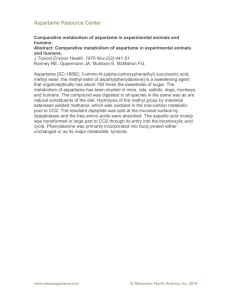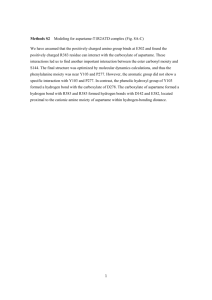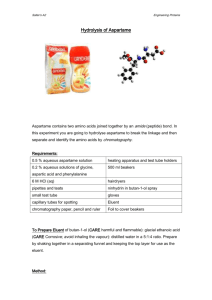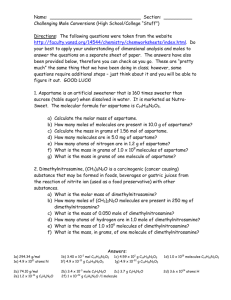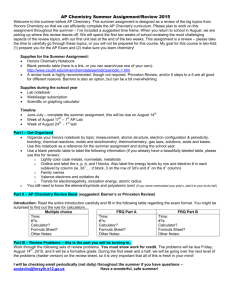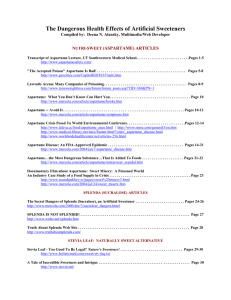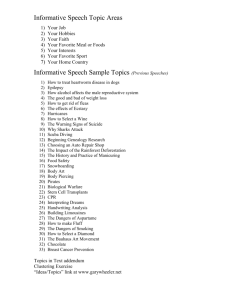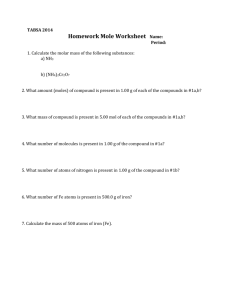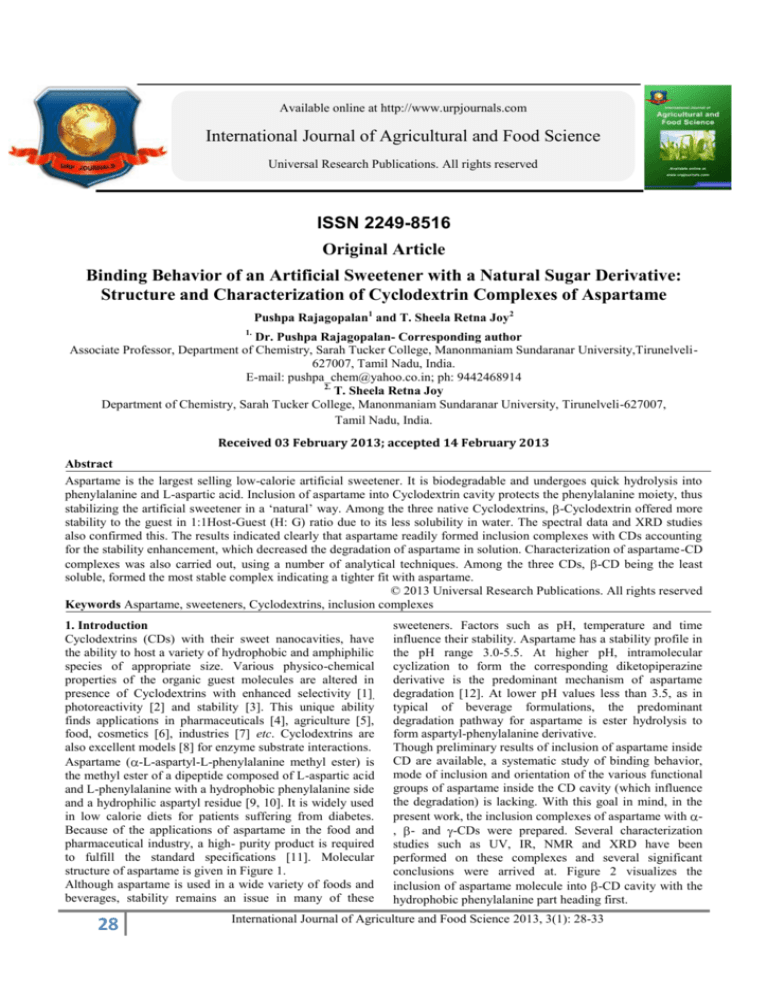
Available online at http://www.urpjournals.com
International Journal of Agricultural and Food Science
Universal Research Publications. All rights reserved
ISSN 2249-8516
Original Article
Binding Behavior of an Artificial Sweetener with a Natural Sugar Derivative:
Structure and Characterization of Cyclodextrin Complexes of Aspartame
Pushpa Rajagopalan1 and T. Sheela Retna Joy2
1.
Dr. Pushpa Rajagopalan- Corresponding author
Associate Professor, Department of Chemistry, Sarah Tucker College, Manonmaniam Sundaranar University,Tirunelveli627007, Tamil Nadu, India.
E-mail: pushpa_chem@yahoo.co.in; ph: 9442468914
2.
T. Sheela Retna Joy
Department of Chemistry, Sarah Tucker College, Manonmaniam Sundaranar University, Tirunelveli-627007,
Tamil Nadu, India.
Received 03 February 2013; accepted 14 February 2013
Abstract
Aspartame is the largest selling low-calorie artificial sweetener. It is biodegradable and undergoes quick hydrolysis into
phenylalanine and L-aspartic acid. Inclusion of aspartame into Cyclodextrin cavity protects the phenylalanine moiety, thus
stabilizing the artificial sweetener in a ‘natural’ way. Among the three native Cyclodextrins, -Cyclodextrin offered more
stability to the guest in 1:1Host-Guest (H: G) ratio due to its less solubility in water. The spectral data and XRD studies
also confirmed this. The results indicated clearly that aspartame readily formed inclusion complexes with CDs accounting
for the stability enhancement, which decreased the degradation of aspartame in solution. Characterization of aspartame-CD
complexes was also carried out, using a number of analytical techniques. Among the three CDs, -CD being the least
soluble, formed the most stable complex indicating a tighter fit with aspartame.
© 2013 Universal Research Publications. All rights reserved
Keywords Aspartame, sweeteners, Cyclodextrins, inclusion complexes
1. Introduction
Cyclodextrins (CDs) with their sweet nanocavities, have
the ability to host a variety of hydrophobic and amphiphilic
species of appropriate size. Various physico-chemical
properties of the organic guest molecules are altered in
presence of Cyclodextrins with enhanced selectivity [1],
photoreactivity [2] and stability [3]. This unique ability
finds applications in pharmaceuticals [4], agriculture [5],
food, cosmetics [6], industries [7] etc. Cyclodextrins are
also excellent models [8] for enzyme substrate interactions.
Aspartame ( -L-aspartyl-L-phenylalanine methyl ester) is
the methyl ester of a dipeptide composed of L-aspartic acid
and L-phenylalanine with a hydrophobic phenylalanine side
and a hydrophilic aspartyl residue [9, 10]. It is widely used
in low calorie diets for patients suffering from diabetes.
Because of the applications of aspartame in the food and
pharmaceutical industry, a high- purity product is required
to fulfill the standard specifications [11]. Molecular
structure of aspartame is given in Figure 1.
Although aspartame is used in a wide variety of foods and
beverages, stability remains an issue in many of these
28
sweeteners. Factors such as pH, temperature and time
influence their stability. Aspartame has a stability profile in
the pH range 3.0-5.5. At higher pH, intramolecular
cyclization to form the corresponding diketopiperazine
derivative is the predominant mechanism of aspartame
degradation [12]. At lower pH values less than 3.5, as in
typical of beverage formulations, the predominant
degradation pathway for aspartame is ester hydrolysis to
form aspartyl-phenylalanine derivative.
Though preliminary results of inclusion of aspartame inside
CD are available, a systematic study of binding behavior,
mode of inclusion and orientation of the various functional
groups of aspartame inside the CD cavity (which influence
the degradation) is lacking. With this goal in mind, in the
present work, the inclusion complexes of aspartame with , - and -CDs were prepared. Several characterization
studies such as UV, IR, NMR and XRD have been
performed on these complexes and several significant
conclusions were arrived at. Figure 2 visualizes the
inclusion of aspartame molecule into -CD cavity with the
hydrophobic phenylalanine part heading first.
International Journal of Agriculture and Food Science 2013, 3(1): 28-33
Figure 1 a) Neutral and b) Ionic structures of Aspartame
2. Materials and methods
-, -, - Cyclodextrins were purchased from Aldrich and
aspartame was purchased from Himedia. Sodium
monohydrogen phosphate and di hydrogen phosphate
(Merck) were used for preparation of phosphate buffers.
KCl and HCl used for buffer solutions of lower pH were
also Merck samples.
2.1 Preparation of inclusion complexes of CD with
aspartame
The powdered forms of CD and aspartame were blended in
dry conditions first and then a small volume of water in
which both CD and aspartame partly dissolve, was added,
stirred magnetically for 24 hours. The inclusion complex
was formed as slurry which was then dried to give a
composition containing the inclusion complex. In this
included form, aspartame is stabilized against hydrolysis. If
such a composition was subjected to conditions, which
ordinarily cause hydrolysis of aspartame, the degradation
was found to be reduced.
Binding constants were calculated from Benesi-Hildebrand
plots of [H] [G] / ∆OD Vs [H] + [G].
2.4 Instrumentation methods
The FT-IR (Fourier Transformed Infrared) spectra for the
complexes were recorded in a JASCO FT-IR 410
spectrometer using pressed KBr pellets. UV absorption
spectra were recorded using a UV/VIS Systronics-2201
model double beam spectrophotometer. Proton NMR was
recorded on a Bruker model spectrometer operating at a
proton frequency 400 MHZ using DMSO-d6 as a Solvent.
3. Results and discussion
3.1 Characterization by FT-IR spectroscopy
Table 1 presents the FT-IR frequencies of aspartame in
pure state and in the β-CD complex. There are significant
changes in the frequencies of the complex when compared
with those of the pure substrate, indicating partial or
complete shielding of chromophores in the CD cavity and
are therefore rationalized as being indicative of complex
formation. For aspartame, studies have indicated that the
phenylalanine ring is positioned inside the -CD cavity,
with the methyl ester exposed outward, away from the
cavity. The results get support from literature [13],
according to which aspartame stabilization increases with
increasing proportions of CD. Figures 3 and 4 show FT-IR
spectra of aspartame and 1:1 H-G complex of aspartame
with - CD respectively.
Figure 2 1:1 H-G complex of Aspartame with - CD
2.2 Preparation of stock solutions for UV studies
Stock solution of the substrate (1 x 10 -3 M) was prepared by
weighing a known amount of the substrate and dissolving it
in minimum amount of doubly distilled water and then
sonicated. Appropriate CD (1 x 10 -3 M) stock solutions in
water were prepared.
A known volume of the substrate, buffer and CD solution
were mixed and diluted to 10 ml. These solutions were
stirred for 24 hrs. Absorption spectra were recorded to
calculate the equilibrium constants for the complexes.
2.3 Calculation of binding constants
Benesi-Hildebrand equation (B.H equation) was used to
calculate the equilibrium constants for the 1:1 inclusion
complexes formed between the substrate and the CD from
UV and emission studies.
[CD][subst rate] [CD] [substrate]
1
ΔOD
Δε
K f Δε
29
Figure 3 FT-IR Spectrum of Aspartame
Figure 4 FT-IR Spectrum of Aspartame- β-CD 1:1
complex
International Journal of Agriculture and Food Science 2013, 3(1): 28-33
Table 1 FT-IR frequencies ( cm-1) of pure Aspartame and its complex with - CD
Functional Groups
Free Aspartame
Complex of aspartame in β-CD
NH3+ stretching
3316
3337
2949
2949.53
C=O stretching (ester)
1737
1736
C=O stretching (amide)
1663
1665
COO¯ asymmetric stretching
1589
1545
NH3+ (combination
band and overtone)
*FT-IR recorded in KBr disc
3.2 UV/Visible - absorption spectra
The complexation between aspartame and CDs has also
been established by UV/Visible spectrophotometric
method. The UV spectra of aspartame with the various CDs
are given in Figures 5, 6 and 7, recorded at two different
pH values 2.5 and 12.5, using buffers. The pKa 1 and pKa2
values for aspartame are 3.2 and 4.8 respectively. There is
only one peak (λ max= 206 nm) at lower pH and there are
two peaks (λ1= 255 nm and λ2= 295 nm) at higher pH.
This shows that aspartame is not hydrolyzed at lower pH
and at a higher pH it is hydrolyzed into aspartyl and
phenylalanine residues. The significant difference in max
values and absorbance confirms the stabilization of
aspartame in the CD cavity. Thus it may be concluded that
aspartame is stabilized against hydrolysis and cyclization,
upon the addition of CDs.
Figure 5 UV Spectra of Aspartame with α-CD at a) pH = 2.5 and b) pH = 12.5; [Aspartame] = 1x10-3 M;
[CD] = 0-2x10-3 M. The insets are Benesi- Hildebrand plots [G] [H]/∆A Vs [G] + [H]; Kb= slope/ intercept
Figure 6 UV Spectra of Aspartame with β-CD at a) pH = 2.5 and b) pH =12.5; [Aspartame] = 1x10-3 M; [CD] = 0-2x10-3
M. The insets are Benesi- Hildebrand plots, [G] [H]/∆A Vs [G] + [H]; Kb= slope/ intercept
30
International Journal of Agriculture and Food Science 2013, 3(1): 28-33
Figure 7 UV Spectra of Aspartame with γ-CD at a) pH=2.5
and b) pH =12.5; [Aspartame] = 1x10-3 M; [CD] = 0-2x10-3
M. The insets are Benesi- Hildebrand plots [G] [H]/∆A Vs
[G] + [H]; Kb= slope/ intercept
3.3 Stability studies
Many interesting conclusions can be drawn from stability
studies of aspartame with CDs. Kb (binding constant) values for
the complexes of aspartame with -CD at the both (lower
and higher) pH values are almost the same and also the
value is very low, revealing that the conditions are not
favorable for inclusion of aspartame into the smaller cavity
of -CD. With -CD the stabilities are very high which is
attributed to a tighter fit inside the cavity compared to CD. -CD with the largest cavity dimension, forms a more
stable complex than -CD but less stable than β-CD. Of the
three CDs β-CD is the most sparingly soluble and hence the
inclusion complex with aspartame is most stable compared
to the other CDs that are highly soluble in water. In all the
three CDs, binding constants are higher at pH 2.4 compared
to pH 12.5 as given in Table 2.
Table 2 Binding constants of complexes of aspartame with
-, -and -CDs at pH = 2.5 and pH =12.5 from UV data
Kb (M-1) of complexes of aspartame in CD
pH
-CD
-CD
-CD
2.5
113..59
2973..68
120.0
12.5
94.83
338.32
110.0
a
Binding constants(Kb) from Benesi-Hildebrand plots ;
Kb= slope/ intercept
31
Figure 8 1H NMR of a) 1:1 complex of Aspartame- β-CD
b) Aspartame c) β-CD
3.4 Proton Nuclear Magnetic (1H NMR) Resonance
Spectroscopy
Fig.8 depicts the NMR spectra of Aspartame, β-CD and the
1:1 complexof aspartame with β-CD. In CD molecule,
hydrogen atoms are located in interior of cavity (H3 and
H5) and outer surface cavity (H1,H2,H4, and H6).When
any guest molecule gets incorporated in CD cavity,
hydrogen atoms located inside cavity experience significant
changes in δ ppm( parts per million) values. But in case of
association of guest molecule with CD hydrogen atoms on
exterior surface show smaller shifts in δ ppm values .Thus a
positive sign of Δδ ppm shows a downfield displacement
and a negative sign an upfield displacement.
The highest difference was observed on the H3 and H5
protons of the β-CD -0.948 and -0.806 ppm respectively.
These protons are lining the interior of the CD cavity. The
significant up field shifts evidence the strong complexation
with the guest molecule. The minor shifts at H1, H2, H4,
and H6 protons which are on the outer surface of CD also
confirm a smooth and comfortable inclusion of the guest
molecule into the CD cavity. We observed downfield shifts
for aspartame protons and upfield shifts for β-CD protons,
upon hydrophobic interactions between both. Chemical
shifts of β-CD in free host and the complex are tabulated in
Table 3. There are prominent changes in the chemical shift
values of the β-CD protons on complexation with
aspartame. The shifts are more dominant in H3 (from
3.88ppm to 2.932 ppm) and H5 (from 3.77ppm to 2.964
International Journal of Agriculture and Food Science 2013, 3(1): 28-33
Table 3 Chemical shifts δ (ppm) of β-CD in free host and
inclusion complex
β-CD-Aspartame
β-CD
β-CD ppm
Complex
H4
3.51(t)
3.87(t)
H2
3.57(d)
3.43(d)
H5
3.77(s)
2.964(s)
H6
3.80(s)
3.075(s)
H3
3.88(t)
2.932(t)
H1
4.99(d)
4.474 (d)
ppm- parts per million; t- triplet; d- doublet; s- singlet
ppm) protons which lie on the interior side of the host
cavity. Hence there is not only complexation, but also
inclusion of aspartame into β-CD cavity.
3.5 X – Ray diffraction Studies
Free aspartame is a crystalline solid. The XRD pattern of
the inclusion complexes of the sweetener with α- , β- and γCDs as shown in figures9-12 reveals the presence of both
guest and host in the complex, the diffractogram of the CDs
dominating that of the guest confirming inclusion process.
The XRPD pattern of aspartame contained a number of
sharp peaks which is indicative of its crystallinity. The
diffraction pattern of the complex is quite different from
pattern of the guest and CD which shows the sum of both
the patterns. In XRPD of the complex, most of the
characteristic peaks of aspartame disappeared and some
were reduced in intensity. The changes are most prominent
in the complex with β-CD which indicates a successful
inclusion of aspartame in β-CD. The sharp peaks of
complex confirmed its crystalline nature.
Figure 9 XRD pattern of Aspartame
Figure 10 XRD pattern of Aspartame -α-CD complex
32
Figure 11 XRD pattern of Aspartame -β-CD complex
Figure 12 XRD pattern of Aspartame -γ-CD complex
4. Conclusions
The results of this work indicate clearly that aspartame
readily forms inclusion complex with CDs accounting for
the stability enhancement, which decreases the degradation
of aspartame in solution. Characterization of aspartame-CD
complexes has also been carried out, using a number of
analytical techniques. Among the three CDs, -CD forms
the most stable complex, indicating a tighter fit with it
among the three cyclodextrins. Though structure, dynamics
and stability of -CD complexes of aspartame and neotame
have already been reported by NMR methods [17], this
work gives a comparative account of the stabilities of
aspartame with the three native CDs, using UV, IR and
XRD techniques. This work is also of economic
importance, as it advocates CD complexation of aspartame
increases its lifespan, as aspartame is an essential
constituent of the food of diabetics.
Reference
1. Hapiot, F., Tilloy, S., Monflier, E.: Cyclodextrin as
supramolecular host for organometallic complexes.
Chem. Rev. 106 (2006) 767-781.
2. Song, A., Wang, X., Lam K. S.: A convenient
synthesis
of
coumarin-3-carboxylicacid
via
Knovenagel condensation of Meldrum’s acid with ohydroxyaryl aldehydes or ketones. Tetrahedron Lett.
44 (2003) 1755- 1758.
3. Liu, Y., Chen, G. S., Chen, Y., Lin: J. Inclusion
complexes of azadirachtin with native and methylated
cyclodextrins: Solubilisation and binding ability.
Bioorg. Med. Chem.13 (2005) 4037-4042.
4. Uekama, K., Hirayama, F., Irie, T.: Cyclodextrin drug
International Journal of Agriculture and Food Science 2013, 3(1): 28-33
carrier systems. Chem. Rev. 9 (1998) 2045-2076.
Bergamasco, R.C., Zanin, G. M., Moraes, F. F.:
Sulfluramid volatility reduction by - cyclodextrin.
J.Agric. Food Chem. 53 (2005) 1139-1143.
6. Szejtli, J.: Utilization of cyclodextrins in industrial
products and projects. J. Mat. Chem.7 (1997) 575- 587.
7. Hashimoto, H.: Present status of industrial application
of cyclodextrins in Japan. J.Incl. Phenom. Macrocycl.
Chem. A. 44 (2002) 57-62.
8. Peroni, E., Caminati, G., Baglioni, P., Nuti, F., Chelli,
M., Papini, A.M.: A new lipophilic fluorescent probe
for interaction studies of bio active lipo peptides with
membrane models. Bioorg. Med. Chem. Lett. 12
(2002) 1731-1734.
9. Cuppen, H. M., Van Eerd, A. R. T., Meekes, H.:
Needlelike morphology of
aspartame. J. Cryst.
Growth Des.4 (2004) 989 -997.
10. Furedi-Milhofer, H., Kamishny, A., Yano, J., Aserin,
A., Garti, N.: Solubilization of aspartame. Langmuir.
19 (2003) 5984 - 5990.
11. Bautista, L., Pinilla, J., Araciand, J., Martinez, M.:
Adsorption isotherms of
aspartame on commercial
and chemically modified divinylbenzene – Styrene
5.
12.
13.
14.
15.
16.
resins at different temperatures. J. Chem. Eng. Data .
47 (2002) 620 – 627.
Garbow, J. R., Likos, J. J., Schroeder, S. A.: Structure,
dynamics and stability of β-cyclodextrin inclusion
complexes of aspartame and neotame. J. Agric. Food
Chem. 49 (2001) 2053-2060.
Karl, C., Schinoll, W. G.: Aspartame stabilization with
cyclodextrins. U.S. Patent 4751095, (1988).
Harata, K., Uedaira, H.: The circular dichroism spectra
of the -cyclodextrin complex with naphthalene
derivatives. Bull. Chem. Soc. Jpn. 48 (1975) 375-378.
Kodaka, M.: Application of a general rule to induced
circular dichroism of naphthalene derivatives
complexed with cyclodextrins. J. Phys. Chem. A. 102
(1998) 8101-8103.
Bakirci, H., Zhang, X., Nau, W. M.: Induced circular
dichroism and structural assignment of the
cyclodextrin inclusion complexes of bicyclic
azoalkanes. J. Org. Chem.70 (2005) 39-46.
Mark T. Zel, Brian E. Padden, David J. W. Grant,
Marie-Christine Chapeau, Indra Prakash, Eric
J.Munson.: J. Am. Chem. Soc., 12 (1999) 1372-1378.
Source of support: Nil; Conflict of interest: None declared
33
International Journal of Agriculture and Food Science 2013, 3(1): 28-33

